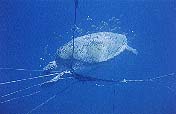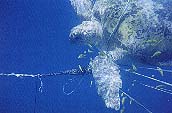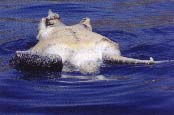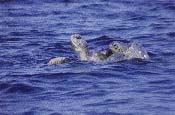TOO MUCH TURTLE TORQUE?
Text and pictures by Robert Baldwin
 Green Light of Fame
Green Light of Fame
At Ra's al Hadd, the easternmost point of Arabia, turtle watchers gather on moonlit beaches almost every weekend. They wait patiently as green turtles (Chelonia mydas) begin to emerge from the sea and haul themselves up the beach to a point above the high tide line. Resting for a moment, the deep breaths of a mature adult, weighing perhaps one hundred and ninety kilograms, are clearly audible. Soft sand flung by the fore flippers surprises unwary onlookers, as she begins to excavate a nest. Half an hour later, an egg chamber, carefully fashioned by the hind flippers, is dug in the bottom of the nest and filled with approximately 110 soft-shelled eggs the size of ping-pong balls. Carefully covering the chamber with sand, the turtle then returns to the sea, her duties as a mother fulfilled.
 While turtle watchers come and go, the eggs remain buried in the sand for approximately 55 days before hatching. An eruption of sand is followed by the appearance of energetic hatchling turtles, small enough to rest easily in the palm of a hand - if they would keep still for long enough. The first to emerge are those who tunnel their way to the surface, whilst the layers below successively push the excavated sand beneath them, rising together, as if on an escalator, towards the surface. Then begins an impulsive race for the sea and a life-long struggle for survival. Even before reaching the pounding waves of a vast and threatening ocean, predators such as wolves, foxes, ratels, seagulls and crabs, see to the demise of most of the hatchlings. As little as two or three in every ten thousand have been estimated to survive to adulthood.
While turtle watchers come and go, the eggs remain buried in the sand for approximately 55 days before hatching. An eruption of sand is followed by the appearance of energetic hatchling turtles, small enough to rest easily in the palm of a hand - if they would keep still for long enough. The first to emerge are those who tunnel their way to the surface, whilst the layers below successively push the excavated sand beneath them, rising together, as if on an escalator, towards the surface. Then begins an impulsive race for the sea and a life-long struggle for survival. Even before reaching the pounding waves of a vast and threatening ocean, predators such as wolves, foxes, ratels, seagulls and crabs, see to the demise of most of the hatchlings. As little as two or three in every ten thousand have been estimated to survive to adulthood.
In spite of the odds, green turtles, have been nesting on the beaches of Ra's al Hadd, for centuries. The egg-laying effort has therefore been worthwhile and has succeeded in maintaining a large population. Recognizing that the green turtles here constitute probably the largest nesting population in the Indian Ocean (an estimated 12-13000), the Ministry of Regional Municipalities and Environment is playing a vital role in laying the foundation for future generations of turtles. Turtle rangers patrol the beaches in an attempt to ensure undisturbed nesting, whilst data they collect is fed into the management planning process in Muscat. From this will emerge a conservation program, which will be warmly greeted by many and contribute further to the green turtles' increasing fame.
 Talking of Turtles...
Talking of Turtles...
Certainly, the green turtle's renown in Oman is justified. Nesting activity at Ra's al Hadd is unusually high and continues year round. But it is not restricted to this area. Green turtles also nest on over two hundred and sixty other beaches along the coast, the effort of at least 20,000 turtles. However, there is considerably more to talk about in Oman than nesting green turtles alone. For example, hawksbill turtles (Eretmochelys imbricata) nesting on the Daymaniyat Islands in the Gulf of Oman form a nesting population of global importance to this highly endangered species. In addition, how many people are aware that Masirah Island is host to all four of Oman's nesting species of turtle? One of the few sites where olive ridley turtles (Lepidochelys olivacea) are found in the region, Masirah Island also boasts the world's largest nesting population of loggerhead turtles (Caretta caretta). An astonishing 30,000 have been estimated to nest in the months of May and June alone, on stretches of coast totalling no more than 25 kilometres. Together, the loggerhead turtles of Masirah Island lay a calculated average of three million eggs, every year.
Nesting aside, from shallow intertidal shelves to coral reefs and open ocean, turtle feeding grounds in Oman are both rich and extensive. Productive environments supporting favoured foods of the green turtle, including beds of seagrass, shallow lawns of algal turf and copious forests of seasonal kelp, have yielded as many as 100 feeding turtles per kilometre of coast. Whether or not these turtles are part of the same population as those that nest in Oman, is not known. Are they perhaps an exclusive Oman population of feeding and breeding turtles? Are they part of migrant populations passing through the Sultanate, stopping to feed wherever food is abundant? Or are they a mixture of resident and migrant turtles? Tagging studies are underway in an attempt to answer such questions. Already, turtles tagged on Masirah Island and at Ra's al Hadd have reached the shores of the United Arab Emirates, Saudi Arabia, Yemen, Ethiopia, Somalia and Pakistan. Conservation of turtles, that know no international boundaries, is a complicated task and is compounded further by sensitive local issues.
 A Healthy Harvest?
A Healthy Harvest?
In feeding grounds as rich as those in Oman, the harvesters can also become the harvested. On the remote central coast of Bar- al-Hikman, where green turtles congregate to feed in numbers of unknown magnitude, local fishermen continue traditional fishing practices, which include the harpooning and slaughter of turtles for food. With the advent of outboard motor engines, fishermen are able to harpoon many turtles a day, before selecting the most suitable. This they decide by making an incision between the neck and the shoulder, to test the fat content. Fat rich females are preferred and although most of the meat is not used, the turtles are cooked and eaten while still fresh, as tradition dictates. However, coupled with the collection of turtle eggs and accidental capture of turtles in fishing nets, harvest pressures have become unsustainable and the survival of turtles in Oman is now a matter for serious concern. Aware of the need to find a balance between age-old customs and the requirements of future generations in a modern world, issues such as this form a basis for discussion within government offices. Education is considered a keystone to turtle survival and already there is evidence that the message is reaching a receptive audience.
Turtle Torque
On one occasion, a young fisherman came to the rescue of a female green turtle, helplessly entangled in the float-line of a fish trap, set by other members of his village. Tightly wound around the turtle's fore flipper, the torque of the rope had begun to cut through the flesh at the shoulder joint. Initial panic at the approach of the fisherman caused the turtle, having lost the use of the bound flipper, to swim in desperate circles, worsening her predicament. At first attempting to cut her free, a more effective method of release was soon employed. Taking hold of the carapace, the fisherman spun the turtle around in the water to unwind the rope. Finally, loosened from the rope's hold, she bolted to the surface for one last breath then turned to her rescuer for a brief moment before diving to safety.
The meaning of that final glance from turtle to human, is perhaps captured by the fisherman, who simply remarked that, a turtle which has swum the oceans since a time before the time of his ancestors, but has no voice of her own, knows that action speaks louder than words.
| Subjects | Search
Arabian Wildlife. Volume 1, Number 2